- This topic has 8 replies, 3 voices, and was last updated 8 years, 2 months ago by
 Grant Privett.
Grant Privett.
-
AuthorPosts
-
19 September 2017 at 10:24 pm #573843
 Bill WardParticipant
Bill WardParticipantHi,
Was looking through material from earlier in the year and I found some stuff I meant to post a while back. Using my “Narrow field Of View EXperiment” (NOVEX) and the spectro systems I’d recorded some meteors that stood out by way of their unusual light curves.
They appeared right at maximum brightness and then faded. Some further reading revealed this to be considered a characteristic of Ni/Fe meteors.

Rather counter intuitively this meteor is travelling bottom to top…
and this one is top to bottom.

The spectra were rather faint but recoverable, thus:

and

They have different dispersions due to being caught on 830 lines/mm and 600 lines/mm gratings’ respectively.
Even though I’ve demonstrated the idea previously it still tickles me when the spectrum “fit” of the various meteors is so good.

So, looks these were made of the same stuff!
The colourised versions look pretty good too.. (should’ve maybe trimmed them so they align, next time … ;-))


A nice result and new view on this type of meteor.
cheers,
Bill.
19 September 2017 at 11:08 pm #578573 Bill WardParticipant
Bill WardParticipantForgot to include the actual light curves..!
These are simple sections taken along the meteor trails using IRIS.
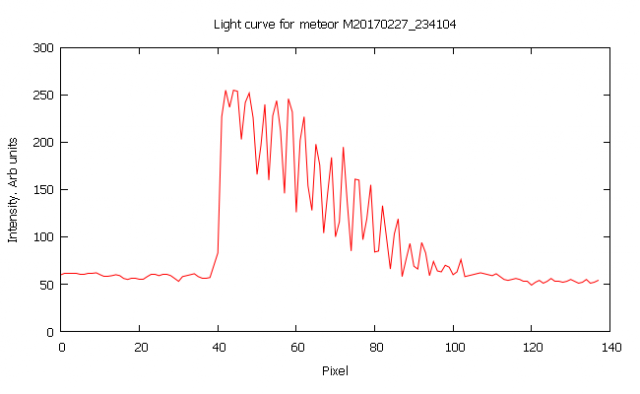
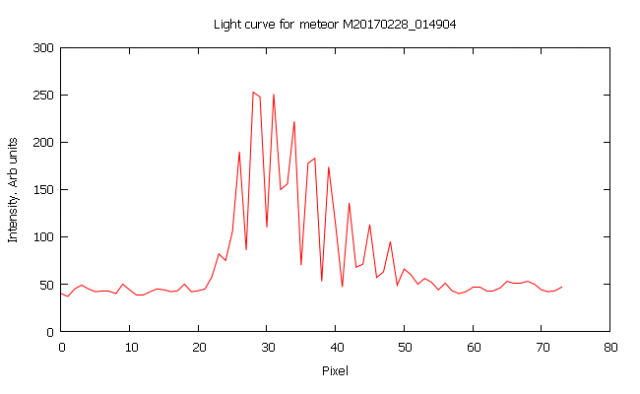
The onset of light emission is dramatic, especially in the first one.
Cheers,
Bill.
8 October 2017 at 12:58 am #578629 Bill WardParticipant
Bill WardParticipantHad a very good nights observing on the 5/6 October. Caught some more meteors with very rapid onsets, perhaps more Fe meteors. Unfortunately didn’t get any spectra of these. However did pick up a few other equally interesting ones. The best had very bright oxygen emission coming from several lines.
Video is here https://youtu.be/EqVVNOun3YI
cheers,
Bill.
15 October 2017 at 10:20 am #578637 Michael O’ConnellParticipant
Michael O’ConnellParticipantNice work Bill. I saw your YouTube clip before seeing this post and was wondering what NOVEX meant. 🙂
If Ni/Fe meteors suddenly appear at maximum brightness and then fade off, can we deduce anything beyond a low Ni/Fe content for meteors displaying the opposite of that?
20 October 2017 at 2:12 am #578651 Bill WardParticipant
Bill WardParticipantHi,
I’m afraid I continue the tradition in astronomical circles of giving every experiment a name based on a ridiculous acronym.
NOVEX stands for NarrOw field of View EXperiment…. ;-))
The smaller FOV’s yield meteors that zip through but if you’re lucky enough to catch one at it’s end you can see some remarkable effects.
As for the iron meteors, they behave the way they do because of the very specific thermo-mechanical properties of the iron/nickel (as you would expect) but you’re correct it cannot be extrapolated the other way as the interface between the meteoroid and the atmosphere has so many variables in terms of both composition and mechanics.
cheers,
Bill.
28 October 2017 at 4:56 pm #578682 Bill WardParticipant
Bill WardParticipantCaught another of these distinctive fellows.
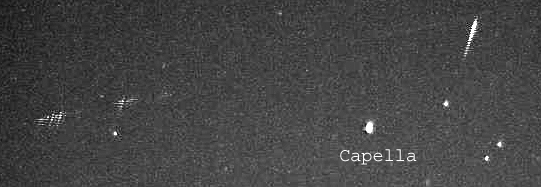
Motion is top to bottom. Spectrum…
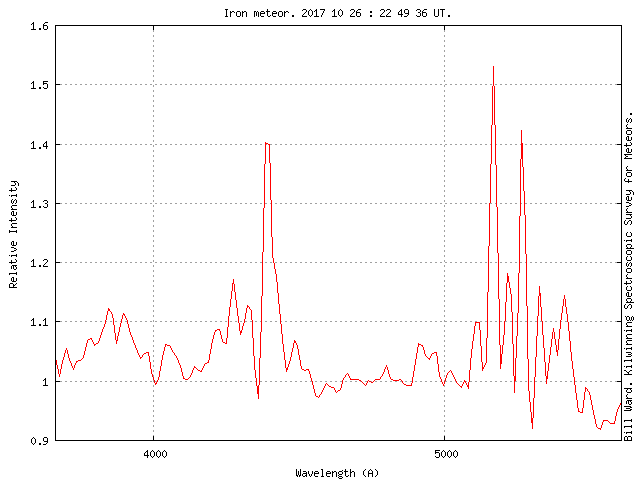
…Colourised…

…and light curve (smoothed)…
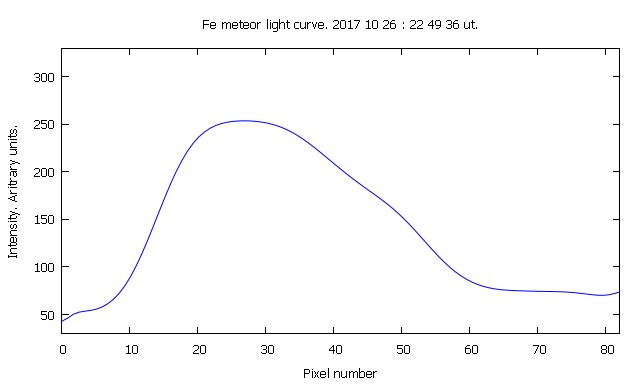
Older text books quote that iron meteors comprise a few perecent of those observed. Now it’s known how they behave in general terms on video we’ll see how many turn up in the coming months/years. Maybe confirm historical observations or suggest an update is required.
cheers,
Bill.
28 October 2017 at 5:59 pm #578683 Grant PrivettParticipant
Grant PrivettParticipantMeteors are not my area of study, but is this an interlaced camera?
The saw pattern on the light curves was interesting.
28 October 2017 at 9:14 pm #578686 Bill WardParticipant
Bill WardParticipantHi,
Yes, all of the WATEC camera’s I use are interlaced. This is both a blessing and a curse! Sometimes the interlacing is useful for timing but of course when looking at photometric issues like the light curve the “chopping” is a nuisance.
Doing some mathematic filtering/smoothing helps the appearence but one looses a little of the genuine rapidity of the onset.
cheers,
Bill.
29 October 2017 at 9:23 am #578689 Grant PrivettParticipant
Grant PrivettParticipantThanks. Thought that might be the case.
As you say, you could do some smoothing but that reduces the temporal resolution. Alternatively, there is processing you could do to assess interline scaling factors, but you would need to do some calibration runs at exactly the same camera settings – perhaps using a non-tumbling satellite as a reference.
-
AuthorPosts
- You must be logged in to reply to this topic.
